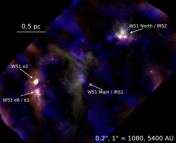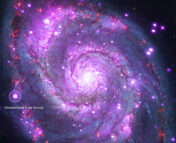Title: Spatially-Resolved Temperature and Density Structures of Nearby HII Regions
Authors: Yifei Jin, Ralph Sutherland, Lisa J. Kewley, and David C. Nicholls
First Author’s Institution: Research School for Astronomy & Astrophysics, Australian National University, Canberra, Australia
Status: Accepted for publication in ApJ [open access]
Despite playing a fundamental role in shaping the emission line spectrum of HII regions, the assumptions about electron temperature and density being constant that are used in most photoionization codes are oversimplified and quite far from reality. In today’s paper, the authors analyzed the detailed electron temperature and density structures of four HII regions to show – spoiler alert! – that the prevailing assumptions are not physically realistic.
For Real
Photoionization, a key process in astrophysics, is the physical mechanism that converts electrically neutral atoms (or molecules) into ions through the interaction with energetic photons. This phenomenon plays a crucial role in determining the characteristics of HII regions, where intense ultraviolet photons from massive stars lead to the ionization of surrounding hydrogen.
The majority of our knowledge about objects in the universe comes from spectroscopy (here is Astrobites’ Guide to Spectroscopy and Spectral Lines). In the case of HII regions, their spectra are dominated by emission lines that trace the characteristics of the emitting gas. Among the physical quantities influencing the emission line spectrum of HII regions are the electron temperature and density. These parameters serve as crucial diagnostics for determining the metallicities of the interstellar medium.
Reality Check

To interpret the spectra of HII regions and understand the complexities of such ionized environments, astronomers rely on photoionization codes. These codes model the interactions between the ionizing radiation emitted by the ionizing source(s) and the surrounding gas, providing insights into:
- the nature of the central star;
- the physical conditions of the ionized nebula;
- and the chemical abundances that characterize the nebula.
Photoionization codes tend to underestimate the complexity of the internal nebular structures of HII regions by assuming an isothermal condition (constant temperature) or a uniform electron density distribution across the extent of these regions. Additionally, in most models, the nebular geometry is assumed to be spherically symmetric, a simplification that often does not align with the real objects – as evident if you compare the HII region diagram in Figure 1 with the images from observations of the four HII regions studied in the paper in Figure 2!
What’s Real vs. The Models
The authors of today’s paper utilized integral field unit (IFU) data from the Wide-Field Spectrograph (WiFeS) on the Australian National University 2.3m telescope to analyze the detailed temperature and density structures of four HII regions in the Magellanic Clouds (Figure 2). IFU instruments enable simultaneous imaging and spectroscopy observations, generating a spatially-resolved data product called a datacube that contains spectral information at each spatial pixel (spaxel). This paper represents the first investigation into the nebular internal structures with a sample of extragalactic HII regions using IFU data with a high spatial resolution.

To derive electron temperatures from the data, our authors used the temperature-sensitive [O III]line ratio, and the density-sensitive [O II] and [S II] line ratios for the electron densities. The MAPPINGS V photoionization code was employed to create models, incorporating stellar atmosphere libraries as input for the ionizing sources’ spectra and using spherical nebular geometry assumptions for the shapes of the HII regions. MAPPINGS V generated a set of HII region models with line fluxes for all the emission lines within the set threshold (specified in the source file).
Figure 3 compares the radial profiles of the temperature- and density-sensitive line ratios between the observed and modeled values derived from the best-fit models (those with minimal χ2 values) for all four HII regions. The models predict that the density-sensitive [O II] and [S II] line ratios increase (top row) and remain flat (bottom row), respectively, with the distance to the center of the nebula. On the other hand, the observational data show a decreasing trend for [O II] line ratios, while [S II] ratios increase. Meanwhile, the observed radial profiles of the temperature-sensitive [O III] line ratios are flat (middle row) for all four regions, but the models predict decreasing profiles. These discrepancies suggest that none of the simple HII regions models is able to reproduce the observed electron temperature and density structures.

Let’s Be Real
Real HII regions exhibit notable radial variations in electron temperatures and densities, challenging the assumption of isothermal and/or constant density in photoionization codes. Codes like MAPPINGS V require assumptions about the shape of HII regions as input. Today’s authors have demonstrated in their paper, the pressing need to model realistic HII regions for accurate nebula modeling, emphasizing the importance of considering the arbitrary geometries inherent in these regions. As our understanding advances, the demand for a more realistic modeling approach heightens. Ongoing developments in three-dimensional photoionization codes with Monte Carlo radiative transfer techniques (for more reading about the basic principle of this technique, this page is a good start) hold the promise of a new era in astrophysical simulations, providing a more physically realistic portrayal of these fascinating objects!
Astrobite edited by Roel Lefever
Featured image credit: Emission line maps of HII region SMC N77A, Figure 2 from the paper.




